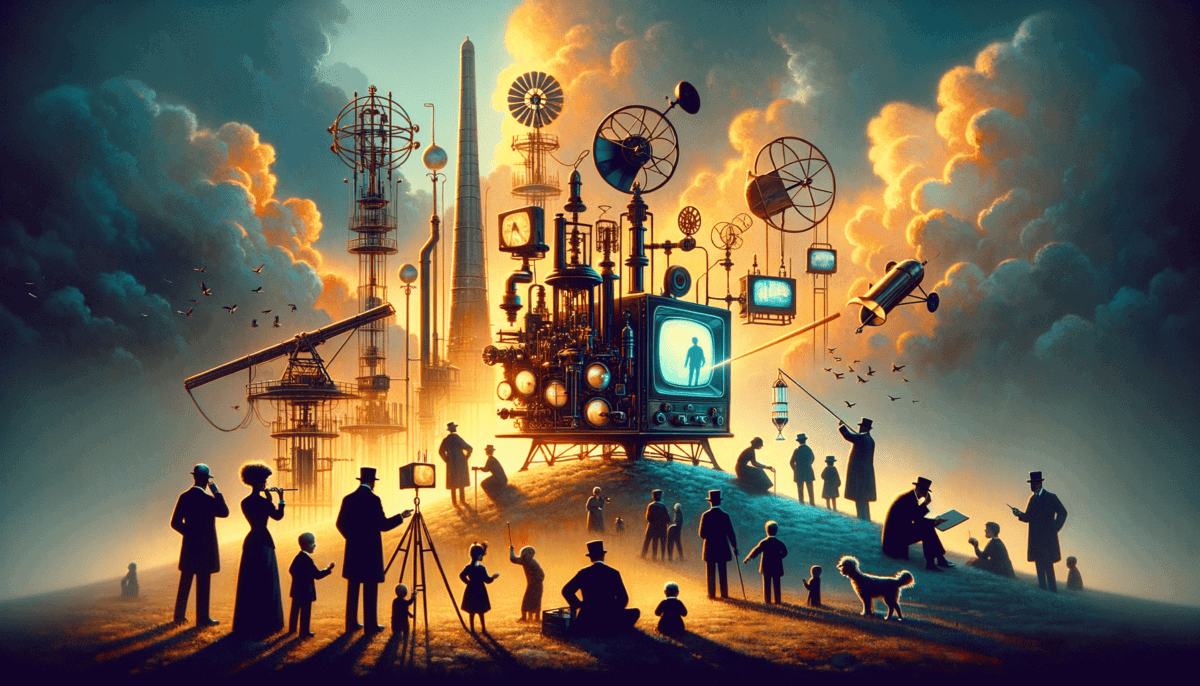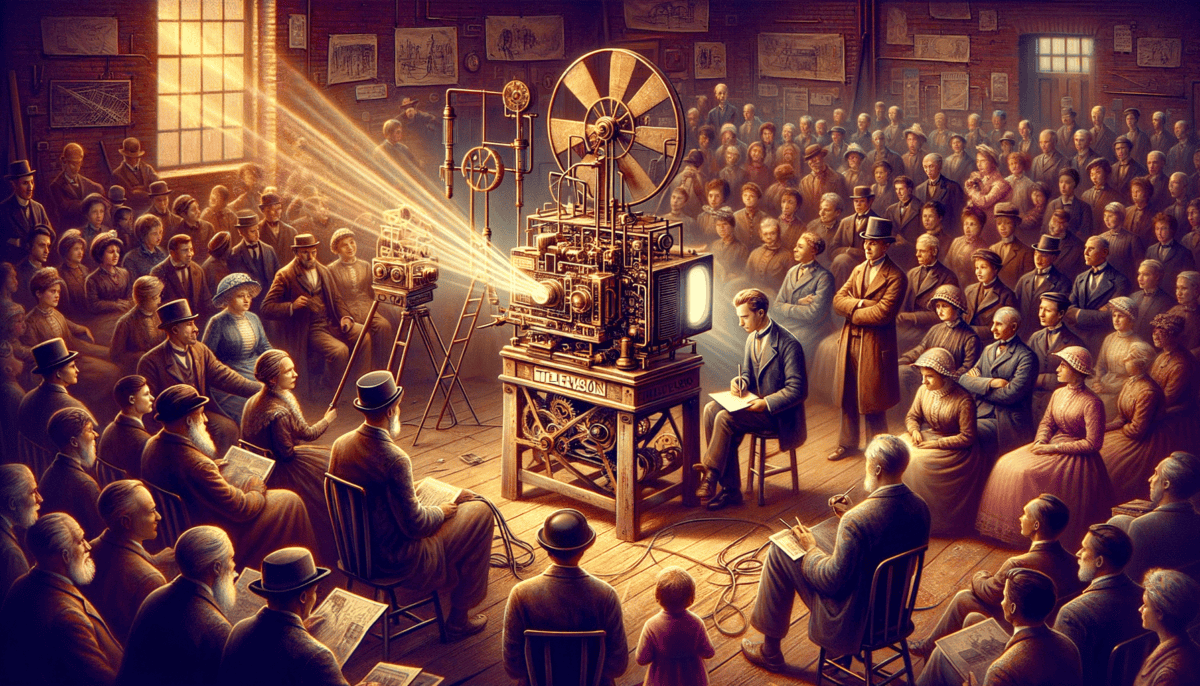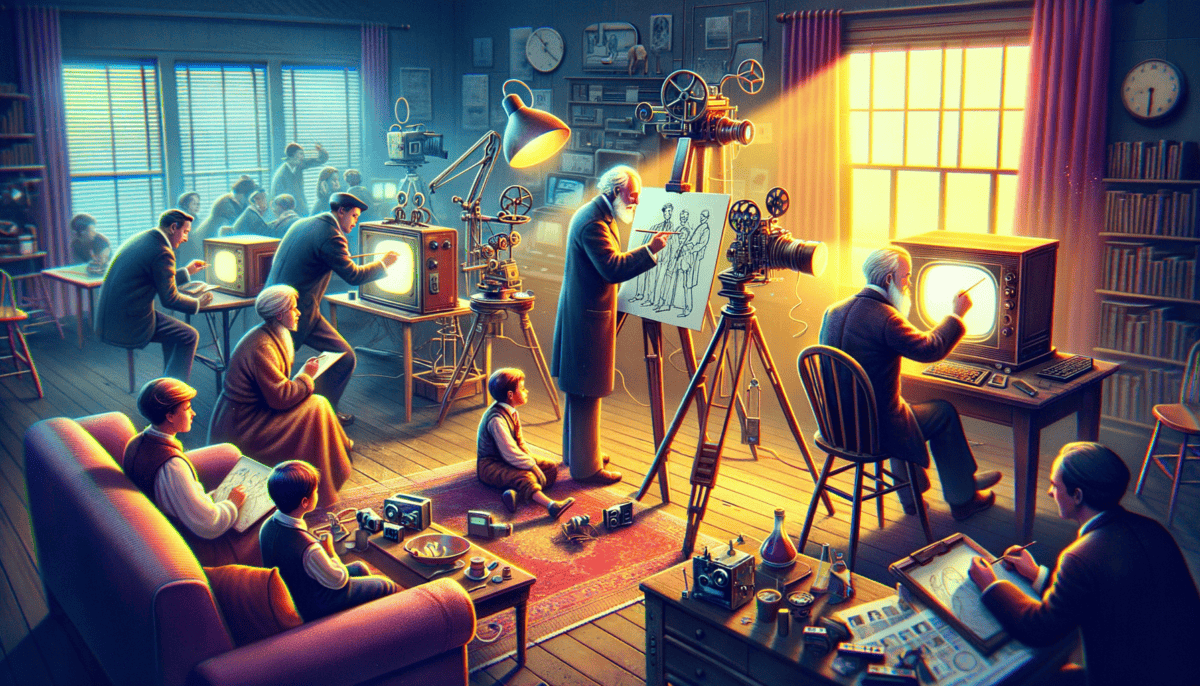The Dream Begins
On a chilly morning in 1920, fourteen-year-old Philo Farnsworth walked behind his horse-drawn harrow in the potato fields of Idaho. As he looked at the neat rows he was making in the soil, something amazing popped into his mind.
“What if I could send pictures through the air, line by line, just like I’m plowing these rows?” Philo whispered to himself, his eyes sparkling with excitement.
Back at home, Philo’s mother smiled as she watched her son scribbling in his notebook. “What are you working on now, dear?” she asked.
“Mom, I have this amazing idea!” Philo jumped up, his eyes bright. “I think I know how to make pictures fly through the air into people’s homes!”
His little sister Pem giggled. “Pictures can’t fly, silly!”
But Philo wasn’t listening. He was too busy drawing his idea – a special box that could catch pictures and send them through the air, just like magic! ✨
Every day after his farm chores, Philo would:
- Read science books
- Draw his ideas in notebooks
- Build small machines from spare parts
- Dream about his flying pictures invention
Life wasn’t easy for young Philo. His family didn’t have much money, and they moved around a lot. But he never gave up on his big dream. He kept thinking and drawing and planning.
One night, as Philo worked by candlelight, his mother brought him a cup of hot chocolate. “You should get some sleep, dear,” she said softly.
“Just a few more minutes, Mom,” Philo replied, not looking up from his drawings. “I think I’m really close to something special.”
He didn’t know it then, but that farm boy with big dreams would one day change the world. His flying pictures machine would become something we all know today – the television!
As young Philo fell asleep that night, his mind was full of wonderful ideas. He dreamed of a future where people everywhere could see pictures from far away, right in their own homes.
Rivals and Dreamers
While young Philo was dreaming in Idaho, other inventors around the world were also trying to make pictures fly through the air. It was like a big race to create something amazing!
In a cold laboratory in Scotland, John Logie Baird wrapped his scarf tighter as he worked. “Almost there,” he muttered, turning knobs on his strange-looking machine.
“What in the world are you making?” his neighbor asked, peeking into his workshop.
“A television!” Baird replied excitedly. “It’s like a radio, but for pictures!”
Meanwhile, far away in Russia, another inventor named Vladimir Zworykin was working hard too. His hands moved quickly as he built his own special machine. ⚡
These inventors faced many problems like:
- Parts that broke easily
- Pictures that came out blurry
- Machines that got too hot
- People who said it couldn’t be done
But they never gave up! Each inventor had their own special way of trying to make television work.
“It’s impossible!” some people said. “Pictures can’t travel through the air!”
But Baird just smiled and kept working. “Nothing is impossible,” he would say, “if you try hard enough.”
One day, Zworykin showed his invention to some important scientists. The room was very quiet as he turned it on. Then suddenly – a tiny picture appeared!
“It works!” someone shouted. Everyone clapped and cheered.
Back in Idaho, young Philo read about these other inventors in the newspaper. Instead of feeling scared, he got even more excited! Now he knew for sure that his dream could come true.
“We’re all trying to do the same thing,” he thought, “but maybe my way will work even better!”
All around the world, inventors stayed up late, working hard on their machines. Each one hoped their television would be the one to change the world forever. And soon, one of them would make history! ⭐
Breaking Through
The sun was just rising when Philo rushed into his laboratory. Today felt different – special somehow. His hands trembled with excitement as he set up his latest experiment.
“Ready?” he asked his wife Pem, who helped him with all his experiments.
“Ready!” she replied, holding up a simple drawing of a straight line.
The machine hummed to life. Philo held his breath. Then suddenly – there it was! A clear, bright line appeared on the screen! ⚡
But getting one line to show up was just the beginning. The inventors faced many big problems like:
- Making pictures clearer ️
- Sending pictures farther
- Keeping the machine cool ❄️
- Making it work every time ✅
Meanwhile, other inventors were making progress too. They all rushed to the patent office to protect their ideas.
“These young men claim they can send pictures through the air?” one scientist laughed. “Impossible!”
But Philo just smiled and kept working. Each day, his pictures got better and better. Soon he could show simple shapes, then letters, and finally real objects!
“Look what I made!” Zworykin called from his lab across the country. His machine was working too!
Scientists started visiting the laboratories to see these magical machines. Their eyes got big when they saw pictures floating through the air.
“How does it work?” they asked.
Philo explained: “We break the picture into tiny dots of light. Then we send them super fast through the air. The TV puts them back together like a puzzle!” ✨
The newspapers were filled with exciting stories about the new invention. “Television Will Change Everything!” the headlines shouted.
“Soon,” Philo told Pem, “everyone will have one of these in their home. Just imagine – pictures from anywhere in the world, right in your living room!”
The race wasn’t over yet. But now everyone knew for sure – television wasn’t just a dream anymore. It was real, and it was about to change the world forever!
Lights, Camera, Action!
The year was 1928, and something amazing was about to happen. People crowded around a strange box in New York City. Their eyes were wide with wonder.
“Ladies and gentlemen,” the announcer said, “welcome to the future!”
The screen flickered to life. There was a man’s face, speaking and smiling! The crowd gasped. Some people clapped. Others just stared with their mouths open.
The first TV shows were very simple. Here are some things people saw:
- People talking ️
- Simple puppet shows
- News readers
- Weather reports ☔
- Musical performances
The pictures weren’t perfect. Sometimes they were blurry or jumpy. The screen was small, about the size of a postcard. But nobody cared – they were too excited!
“This will never catch on,” some people said. “Who wants to watch a tiny screen when you can go to the movies?”
But more and more people wanted their own TV. Stores couldn’t keep them in stock! ️
“How much does one cost?” families asked.
“$200!” the shopkeeper would say. That was a lot of money back then – like buying a very fancy phone today!
TV stations started opening in big cities. They needed lots of new workers:
Camera operators
Directors
Actors
Writers
“We’re making history,” Philo said as he watched a broadcast. “Soon, people everywhere will learn about the world through television.”
Television was changing how people spent their time. Instead of only reading books or listening to radio, now they could watch stories come to life!
The inventors kept working to make TV better. They wanted bigger screens, clearer pictures, and more channels. There was still so much to do! ⭐
But one thing was clear – television wasn’t just an invention anymore. It was becoming part of everyday life, and it was here to stay!
A New World of Entertainment
By 1935, television stores were popping up everywhere! Little boxes with moving pictures were changing how people lived. Families saved money to buy their very own TV set.
“Mommy, can we get one?” Tommy asked, pressing his nose against a store window.
“They’re getting cheaper,” his mother smiled. “Maybe for Christmas!”
TV changed how families spent time together:
- Dinner in front of the TV ️
- Saturday morning cartoons
- Family game shows
- Evening news time
- Special movie nights
Companies started making TV shows for kids. Puppet shows and cartoons made children laugh and learn. Parents liked that TV could teach their kids new things.
“Look what I learned on TV today!” became something kids said every day.
Artists drew cartoons
Actors performed in shows
Musicians played theme songs
Writers created stories
“Television brings the world into your living room,” read one advertisement. And it was true! People could see places they’d never visited and learn about different cultures.
TV stations grew bigger and better. They started showing:
Sports games
Theater plays
Circus shows
Music concerts
Even stores changed because of TV. They put TVs in their windows to attract customers. Restaurants added TVs so people could watch while eating. ️
The inventors were amazed at how their creation had grown. “We didn’t just make a machine,” Philo said. “We made a window to the world.”
Television was becoming more than just entertainment. It was teaching people, bringing families together, and showing everyone new ways to see the world. The flickering box that started as a dream was now part of daily life! ✨
A Legacy of Light and Pictures
Today, TV is everywhere! The little box that started with Philo’s dream has grown into something amazing. Let’s see how TV changed everything!
“Grandpa, tell me again about your first TV,” little Sarah asked, holding her tiny video phone.
“Well, sweetie,” Grandpa smiled, “it was black and white, and we thought it was magic!” ✨
TV changed in big ways over the years:
- Color pictures replaced black and white
- Screens got bigger and clearer ️
- Shows came from all around the world
- People could record their favorite programs
- TV connected to the internet
TV brought people together in special ways:
Families watched important news together
Kids learned from educational shows
New types of games were invented
Movies came right into homes
“You know,” Teacher Ms. Smith told her class, “before TV, most people never saw what other countries looked like!”
Show pictures clearer than real life
️ Understand voice commands
Play amazing games
Connect to phones and computers
The inventors would be so happy to see how their dream grew. TV still brings families together, teaches new things, and shows amazing stories.
Now, new inventions are making TV even better! Smart TVs can:
Play any song you want
Show digital books
Display beautiful art
Let you talk to friends far away
The story of television shows us that big dreams can come true. One boy’s idea turned into something that changed the whole world. Maybe you’ll invent something amazing too! ⭐
Every time we turn on a TV, we’re seeing the magic that started with a young boy drawing pictures in a notebook. The flickering box that changed the world keeps changing, getting better, and bringing new wonders into our homes.






